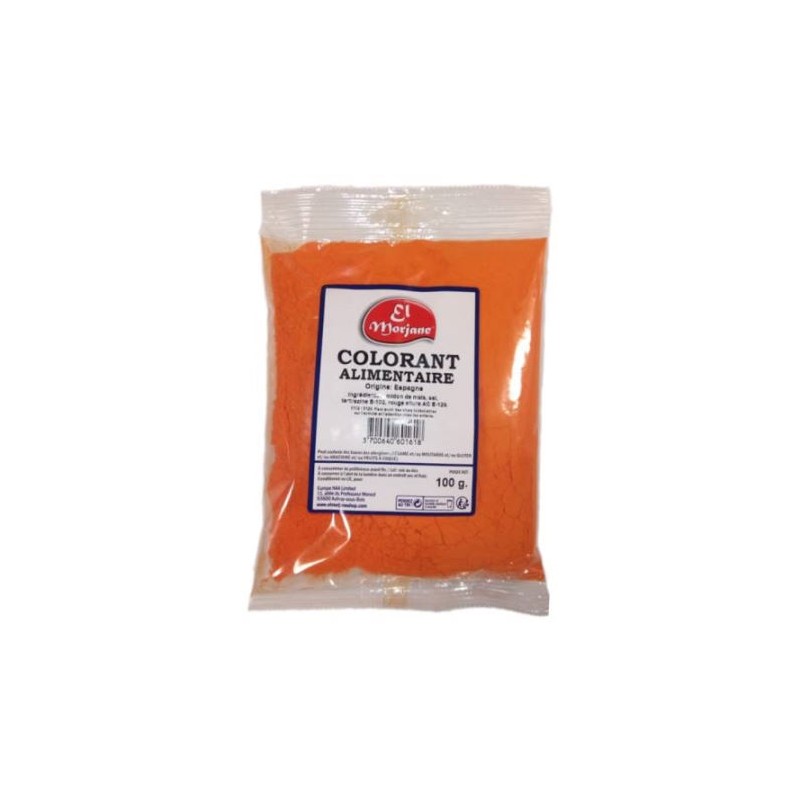

 From 6 items purchased the cheapest is offered.
From 6 items purchased the cheapest is offered.


€13.19 / kg
Bring a touch of magic to your culinary creations with our food coloring in a 100g bag! Easy to use, it will enhance your pastries, icings and drinks with vibrant, natural colors. Give your recipes a vibrant palette, while preserving the quality and authenticity of flavors. Whether you are a professional or a cooking enthusiast, let your imagination run wild with this practical and economical product. Add color, life and originality to every bite!
 Security policy
Security policy
Secure online payment with PayPal and Stripe.
 Delivery policy
Delivery policy
Packages shipped within 24 to 48 business hours, plus delivery time.
 Return policy
Return policy
Returns of goods possible within 14 days, unopened packaging, undamaged products.
 Ecology
Ecology
Out of concern for our planet, we will use empty boxes from our sold products.
Description
Food coloring is a substance added to food products with the aim of giving them an attractive color. These colors can be natural or synthetic in origin and are used in a variety of products, from candies and drinks to baked goods and prepared foods. The purpose of adding coloring to foods is not only to make them visually pleasing, but also to maintain a uniform color and maintain the appearance of the product after cooking or storage. Food colorings can be divided into several categories:
- Natural colors: These are derived from natural sources, such as plants, fruits, vegetables, minerals and insects. For example, turmeric for a yellow tint or beet juice for a red color.
- Artificial or synthetic dyes: These are dyes created from chemicals. They are often used for their lower cost and longer stability in food products. Among the best known, we find dyes like E129 (Allura Red AC) or E133 (Brilliant Blue FCF). Food colors are also used in cosmetics, pharmaceuticals and even some textile products. Food colors are regulated by public health authorities, such as the FDA (Food and Drug Administration) in the United States and the EFSA (European Food Safety Authority) in Europe.
Usage
Food colors have varied uses in the food industry. They allow you to:
- Improve the appearance of food products: This can be particularly important in attracting consumers to mass-market products such as candies, desserts, soft drinks, and sauces.
- Restore color after a manufacturing or storage process: Processes like cooking or storage can alter the color of food. For example, certain foods like meats or cheeses may lose their color over time, affecting their visual appeal.
- Standardize colors: In the case of products like candies or cakes, it is crucial that each batch has a uniform color. Food coloring ensures visual consistency.
- Sensory meaning: Color can influence the perceived taste of a product. For example, a red liquid might be paired with a strawberry or cherry flavor.
- Decoration and presentation: In baking, colorings are used to decorate cakes, cookies, ice creams and other desserts.
- Create visual effects: For example, in products containing multiple layers of color, dye can be used to create attractive visual effects.
History
The use of food coloring dates back centuries. Initially, dyes were extracted from natural sources. Here is a brief timeline:
- Antiquity: The first dyes were obtained from plants and minerals. For example, the Romans used saffron to give a yellow color to foods, and the Indians used turmeric and other plants to color their dishes. Red was sometimes obtained from the cochineal insect, whose eggs are ground to produce a natural dye.
- Middle Ages: Natural dyes were commonly used in cooking, and pigments from plants and insects were used in drinks and confectionery
- Industrial Revolution: In the 19th century, the industrial revolution favored the rise of artificial colorings. The first synthetic dye, "mauveine" (purple), was discovered by William Henry Perkin in 1856. This marked the beginning of an era where artificial dyes began to be widely used in the food industry.
- 20th century: Regulation of food coloring began to increase in the 1900s, with the implementation of more rigorous safety testing. Dyes such as tartrazine (Yellow 5) and allura red have been approved in several countries.
- Today: Food colors are subject to strict safety testing in many countries. Research focuses on the safety of synthetic dyes, as well as the potential benefits of natural dyes, which are seeing renewed interest.
Benefits
Food coloring, whether natural or artificial, has several benefits, although there is debate about its use. Here are some of their advantages:
- Improved visual appeal: A colorful food attracts consumers' attention more easily, especially in products aimed at children, such as candies and sugary drinks.
- Color stability: Artificial colors, in particular, are often more stable than their natural counterparts. This means they are more resistant to exposure to heat, light and humidity, helping to maintain uniform color in food products over a longer period of time.
- Accessibility and profitability: Artificial colors are generally less expensive to produce than natural colors, making them more accessible to mass food manufacturers.
- Source of creativity in the kitchen: Food colors offer a diverse color palette and can be used to create visually stunning products, such as decorated cakes, multi-colored confectionery or brightly hued drinks.
- Reduced risks of contamination and deterioration: In some cases, the use of natural colors may be associated with other beneficial properties. For example, turmeric, which is used for its yellow color, also contains curcumin, an antioxidant.
- Meeting consumer expectations: Today, many consumers are looking for healthier and more natural products. As a result, natural colors, such as those from fruits, vegetables and spices, have become popular in "organic" or "natural" food products. These dyes may also be perceived as safer and less likely to cause side effects.
- Use in small quantities: The majority of food colors are used in low concentrations, so that they do not significantly affect the nutritional composition of the products.
Precautions and Considerations
Although food colors provide many benefits, some recall concerns about their safety, especially artificial colors. Some may cause allergic reactions or be associated with side effects, such as hyperactivity disorders in some children, although research is still ongoing. Therefore, the use of certain dyes is regulated and they must go through safety tests before being approved. In contrast, natural colors are generally considered safer, although their cost and shelf life limit their use in the large-scale food industry.
Conclusion
Food colors have evolved over time from natural substances used since ancient times to synthetic chemicals that meet specific needs of modern industry. Their role in creating attractive products and their ability to extend the life of foods have made them indispensable, while raising questions about their safety. Whether to give color to candies, to decorate cakes or to maintain the color of a dish, food colorings play a key role in our modern diet.
Ingredients: Corn starch. salt, tartrazine (E102*), azura red AC (E129*).
Produced in EU. Store away from light and heat. Store in a ventilated, dry place.
Allergens: May contain traces of Sesame and/or Mustard and/or Gluten and/or Peanuts and/or Fruit. shell.
*May have adverse effects on activity and attention in children.